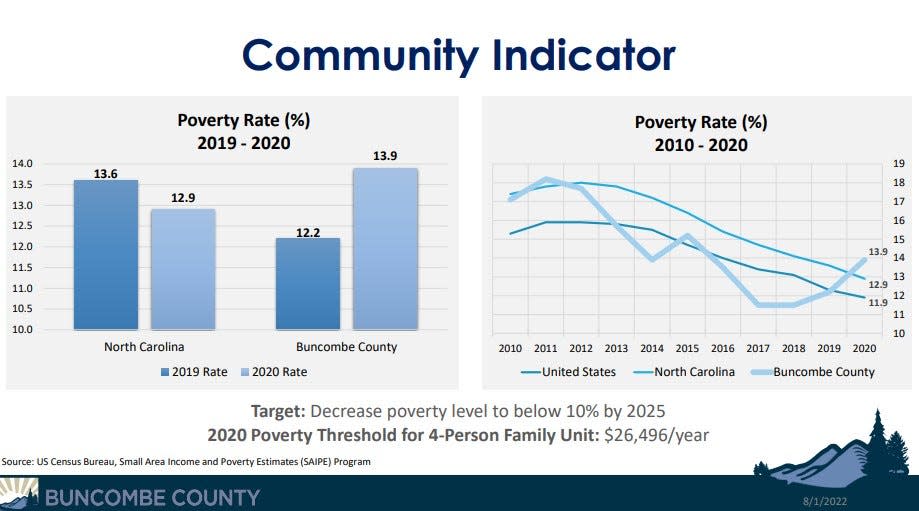‘Wrong direction’ bloating local poverty rate has county commissioners seeking answers

Buncombe County's poverty rate is increasing, and commissioners are asking why as the “wrong direction” trend could hinder the strategic target of less than 10% by 2025.
Economic Development Director Tim Love presented to Board of Commissioners Aug. 2 on the county’s ongoing strategic plan, and some of the findings related to income and economic outlooks for families are grim.
“We’re moving in the wrong direction,” Love told the board. He discussed several graphs based on 2020 U.S. Census Bureau data showing poverty rates in Buncombe have been climbing between 2017-2020, even though they had been falling statewide since roughly 2013.
Dogwood study: Number of WNC under-6 kids who live in poverty; likely underestimated
Buncombe’s poverty rate has moved from about 11.5% in 2017 to 13.9% in 2020 according to the data Love presented. As of 2020, the overall poverty rate in North Carolina was 12.9%, according to census data. Other NC counties, many in the east, have rates at or above 20%.
“That’s not a good thing,” Love said. “That’s something that needs work, and so I think a lot of the work the commission has spent on sort of supporting groups that are in poverty is really important, but we need to continue to bring that into focus.”

The federal poverty level for a family of four in 2020 was a household income of $26,496, according to Love’s presentation.
According to figures from the Assistant Secretary for Planning and Evaluation, the current poverty level is a household income of $27,750 for a family of four.
Calculations from the North Carolina Budget and Tax Center estimate a family of four would need $72,700 annually in order to meet a living wage standard.
Related: Buncombe got $3 million for Tropical Storm Fred recovery; here's how it will be spent
Board Chair Brownie Newman asked Love if his staff had data on what percentage of families in poverty were employed.
Love said he would take a look at it.
“It would be interesting to follow up on that, recognizing that we have this super low unemployment rate yet the poverty rate is actually going up,” Newman said.
As of June, the Asheville area’s unemployment rate was 3.4% according to the U.S. Bureau of Labor Statistics, the same as the state of North Carolina’s rate.
Commissioner Jasmine Beach-Ferrara wanted to know what was driving this increase. Commission Parker Sloan wanted to have more data. Commissioner Terri Wells wanted to know if skyrocketing unemployment rates during the heat of the COVID-19 pandemic had an effect on rising local poverty rates. Commissioner Amanda Edwards wanted to know more about the “exodus of working moms” and a lack of child care in the area. Commissioner Al Whitesides wanted to see the poverty data broken down by race.
Related: Buncombe just directed $18.8M in COVID money to 24 projects. Who got the most?
Newman noted the data did not entirely capture the pandemic’s impact, since it was gathered in 2020.
“The questions that you all are asking, this is why we wanted to present this,” Love said. “These are the stories we have to tell.”
Beach-Ferrara wondered out loud if there was an “incident” close to 2017 that caused the poverty rate to rise, running against the North Carolina grain.
Newman noted the chart only captured wages.
“My intuitive answer is that, a lot of the growth we have in the area,” he said. “We’ve got a lot of really affluent people moving here who actually have pretty good wages … but down at the lower-skilled level of the workforce, things are going in the wrong direction for that segment of workers.”
Love said his department is working on a variety of ongoing initiatives that may help increase median household wages to reach the state benchmarks.
Those include:
Continued recruitment of high-wage industries and employers.
Continued growth of workforce development programs like Inclusive Hiring Partners, Accelerate Buncombe, Guided Compass, INspire Recovery.
Investments in Economic Sector via ARPA - $2.4 M toward small business development, job creation/retention & economic relief for impacted sectors
Buncombe County is expected to grow by nearly 70,000 by 2045, according to projections created as part of the ongoing Comprehensive Plan 2043 initiative, a first-of-its-kind project that will result in a document created by governments and residents to determine what the focus and vision of the community should be over the coming 20 years.
Related: Survey: Region businesses need tens of thousands of workers by 2025, face 5 big obstacles
Newman said repeatedly during the Aug. 2 strategic plan briefing he hoped that number would be lower.
According to a forthcoming Mountain Area Workforce Development Board report, 10 mountain area counties will need between roughly 22,000-45,000 new employees by 2025.
Andrew Jones is Buncombe County government and health care reporter for the Asheville Citizen Times, part of the USA TODAY Network. Reach him at @arjonesreports on Facebook and Twitter, 828-226-6203 or arjones@citizentimes.com. Please help support this type of journalism with a subscription to the Citizen Times.
This article originally appeared on Asheville Citizen Times: Buncombe County poverty rates rising while North Carolina's rates drop

